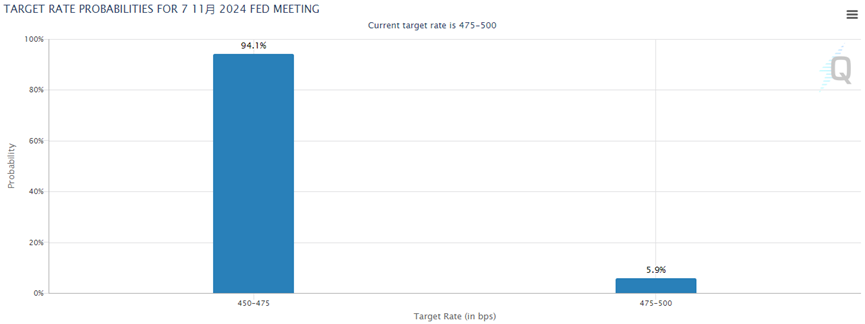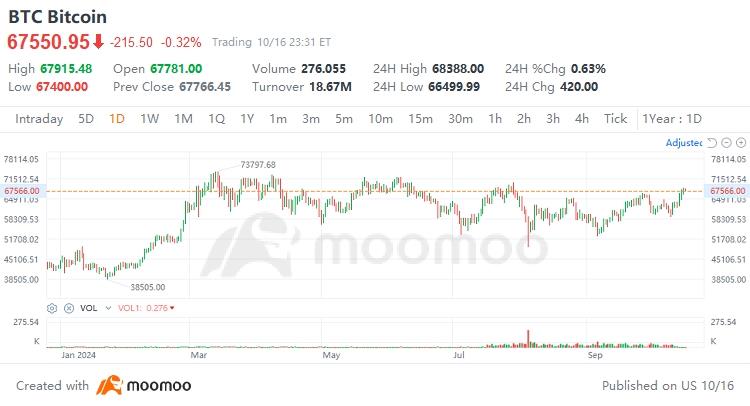Which stock market shines brighter: the U.S. or China?
The Fed cuts rates, and China rolls out economic stimulus measures
On September 18th, the Federal Reserve announced a 50-basis point interest rate cut, setting the target range for the federal funds rate between 4.75% and 5%. The primary reasons for this reduction were easing inflationary pressures, poor employment data, and concerns over a potential recession in the U.S. economy. The U.S. Bureau of Labor Statistics reported that U.S. employment growth in September significantly exceeded expectations, with non-farm payrolls increasing by 254,000, far above the market's forecast of 150,000, and the unemployment rate dropping to 4.1%, lower than the expected 4.2%. The decline in unemployment and the rise in non-farm employment data eased concerns about a worsening U.S. labor market, demonstrating the resilience and growth potential of the U.S. economy. This data not only boosted investor confidence but also dispelled fears of a possible U.S. recession.
According to the CME Group's Fed-Watch tool, the market no longer expects a 50 basis point rate cut at the Federal Reserve's November meeting, with a 94.1% probability of a 25 basis point rate cut and a 5.9% probability of no rate cut.

The Chinese government implemented a series of monetary policy adjustments, including a 0.5 percentage points decrease in the reserve requirement ratio, injecting approximately 1 trillion yuan in long-term liquidity into the financial market; a 0.2 percentage points reduction in the 7-day reverse repo operation rate, from 1.7% to 1.5%; and the Ministry of Finance indicated that it will introduce a package of targeted incremental policy measures. These measures include supporting local governments in resolving hidden debt, aiding large state-owned commercial banks in replenishing core tier-one capital, supporting efforts to stabilize the real estate market, and increasing support for key groups.
Performance of Chinese and U.S. Stock Markets
From September 24th to October 7th, Chinese assets experienced a comprehensive surge, with the $Hang Seng Index (800000.HK)$rising by over 26%, the $Hang Seng TECH Index (800700.HK)$ by over 45%, the $SSE Composite Index (000001.SH)$ by over 26%, and the $Chinext Price Index (399006.SZ)$ by over 66%. Popular Chinese ADRs also saw significant gains, with $Alibaba (BABA.US)$ climbing by over 30%, $PDD Holdings (PDD.US)$ by over 34%, $JD.com (JD.US)$ by over 58%, and $KE Holdings (BEKE.US)$ by over 57%. However, Chinese assets began to decline after October 8th.
Between September 9th and October 14th, the $Nasdaq Composite Index (.IXIC.US)$ advanced by over 10%, the $S&P 500 Index (.SPX.US)$ by over 8%, and the $Dow Jones Industrial Average (.DJI.US)$ by over 6%, with both the S&P 500 and Dow Jones reaching new highs. During this period, $NVIDIA (NVDA.US)$ jumped by over 34%, $Alphabet-A (GOOGL.US)$ rose by over 9%, $Microsoft (MSFT.US)$ by over 4%, $Tesla (TSLA.US)$ by over 4%, and $Apple (AAPL.US)$ by over 4%.
Invest in the U.S. stock market or the Chinese stock market?
The U.S. stock market
Bitcoin prices had a significant surge
Bitcoin's price has surpassed $68,000, with a year-to-date increase of over 60%. Chris King, founder and CEO of the Eaglebrook crypto investment platform, stated that part of the recent rise in Bitcoin is due to the betting market's increased odds on Trump winning the upcoming U.S. presidential election next month. As the election forecast for Trump improves, the crypto market is performing more strongly. There are growing signs that Democratic presidential candidate Harris may be more crypto-friendly than the current Biden administration. Vice President Harris pledged in a speech on Monday to protect crypto assets as part of a campaign strategy to attract African American male voters. After the election results are officially announced, some funds that have been waiting on the sidelines may shift from a hesitant stance to boldly investing in the crypto market.

The AI space is broader and more expansive
Data from the Semiconductor Industry Association (SIA) shows that global semiconductor sales reached $53.12 billion in August, a year-on-year increase of 20.6%, setting a new record for the month of August. Driven by demand related to generative AI, global semiconductor sales have exceeded the previous year for ten consecutive months. NVIDIA co-founder and CEO Jen-Hsun Huang stated at an investor conference hosted by Morgan Stanley that the newly launched Blackwell chip was fully booked before its official launch and may be in short supply for the next 12 months, highlighting the rapid growth in demand in the AI sector. Apple is developing the M4 chip, which will feature a significantly upgraded neural engine dedicated to AI computing tasks. Apple has also launched the multimodal AI model MM1.5, with 30 billion parameters, capable of image recognition and natural language understanding, performing exceptionally well. Apple plans to integrate generative AI into the iPhone 16, further bridging the gap between AI and humans.
The Chinese stock market
As of the end of September 2024, the average P/E ratio of the $SSE 50 Index (000016.SH)$constituents was only 9.81 times, but the median was 14.34 times. In contrast, the $Dow Jones Industrial Average (.DJI.US)$ had an average P/E ratio of 28.49 times and a median of 26.69 times.
The $CSI 300 Index (000300.SH)$ constituents had an average P/E ratio of 11.05 times and a median of 18.40 times, compared to the $S&P 500 Index (.SPX.US)$ with an average P/E ratio of 27.43 times and a median of 26.85 times.
$Chinext Price Index (399006.SZ)$, which has the highest valuation among A-shares, has an average P/E ratio of 23.52 times. In stark contrast, the $NASDAQ 100 Index (.NDX.US)$ shows a significant disparity, with an average P/E ratio of its constituents at 35.92 times.
The $Hang Seng Index (800000.HK)$ has an average P/E ratio of 12.32, which is also much lower than the three major U.S. stock indices. Chinese assets are currently in a value lowland, and with the continuous release of China's government economic stimulus measures, the Chinese stock market is expected to see a return to value.
Related ETFs: $Direxion Daily FTSE China Bull 3X Shares ETF (YINN.US)$, $iShares China Large-Cap ETF (FXI.US)$, $KraneShares CSI China Internet ETF (KWEB.US)$, $Xtrackers Harvest CSI 300 China A-Shares ETF (ASHR.US)$, $iShares MSCI China ETF (MCHI.US)$, $Direxion Daily CSI 300 China A Share Bull 2X Shares (CHAU.US)$, $Invesco China Technology ETF (CQQQ.US)$, $Invesco Golden Dragon China ETF (PGJ.US)$.
Whether it's the U.S. or Chinese stock market, investing requires patience and strategy. Everyone's financial situation and risk tolerance are different. Before making any investment decisions, ensure they align with your personal goals and risk preferences. If your investment logic is sound, even if you experience short-term losses, there will eventually be a return to value.

Source:Bloomberg
Disclaimer: Moomoo Technologies Inc. is providing this content for information and educational use only.
Read more
Comment
Sign in to post a comment

天空1612 : Chinese stock will make you delay retirement![undefined [undefined]](https://static.moomoo.com/nnq/emoji/static/image/default/default-black.png?imageMogr2/thumbnail/36x36)
山芭佬 :![undefined [undefined]](https://static.moomoo.com/nnq/emoji/static/image/default/default-black.png?imageMogr2/thumbnail/36x36)